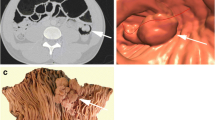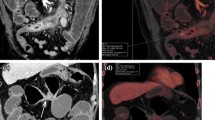Abstract
This work evaluates carbon dioxide as a contrast medium for magnetic resonance imaging of the stomach and small bowel. Twelve healthy volunteers underwent rapid magnetic resonance imaging after oral administration of a carbon dioxide generating agent using a combination of breath-hold and interactive fluoroscopic imaging during breathing. Diagnostic-quality images were obtained in 100% of cases for the stomach and in 92, 75, 67 and 42% of cases for the duodenal segments 1–4, respectively. Visualisation of the jejunum and ileum proved unacceptable for clinical use and anti-peristaltic agents did not significantly influence the results. Further development of fast imaging and magnetic resonance interactive fluoroscopic methods may allow the use of carbon dioxide as a contrast medium for clinical imaging of the stomach and duodenum.




Similar content being viewed by others
References
Gourtsoyiannis N, Papanikolaou N, Grammatikakis J, Prassopoulos P (2002) MR enteroclysis: technical considerations and clinical applications. Eur Radiol 12:2651–2658
Papanikolaou N, Prassopoulos P, Grammatikakis J, Gourtsoyiannis N (2002) Optimization of a contrast medium suitable for conventional enteroclysis, MR enteroclysis, and virtual MR enteroscopy. Abdom Imaging 27(5):517–522
Lomas DJ (2003) Technical developments in bowel MRI. Eur Radiol 13:1058–1071
Sohn KM, Lee JM, Lee SY, Ahn BY, Park SM, Kim KM (2000) Comparing MR imaging and CT in the staging of gastric carcinoma. Am J Roentgenol 174(6):1551–1557
Ajaj W, Goehde SC, Papanikolaou N, Holtmann G, Ruehm SG, Debatin JF, Lauenstein TC (2004) Real time high resolution magnetic resonance imaging for the assessment of gastric motility disorders. Gut 53(9):1256–1261
Levine MS, Rubesin SE, Herlinger H, Laufer I (1988) Double contrast upper gastrointestinal examination: technique and interpretation. Radiology 168:593–602
Tart RP, Li KC, Storm BL, Rolfes RJ, Ang PG (1991) Enteric MRI contrast agents: a comparative study of five potential agents in humans. Magn Reson Imaging 9:559–568
Chou CK, Liu GC, Chen LT, Jaw TS (1993) Retrograde air insufflation in MRI: a technical note. Abdom Imaging 18:211–214
Chou CK, Liu GC, Yang CW, Chen LT, Sheu RS, Jaw TS (1993) Abominal MR imaging following antegrade air introduction into intestinal loops. Abdom Imaging 18:205–210
Morrin MM, Hochman MG, Farrell RJ, Marquesuzaa H, Rosenberg S, Edelman RR (2001) MR colonography using colonic distention with air as the contrast material: work in progress. Am J Roentgenol 176:144–146
Lomas DJ, Sood RR, Graves MJ, Miller R, Hall NR, Dixon AK (2001) MRI of colon carcinoma with carbon dioxide enema—Pilot Study. Radiology 219:558–562
Makki M, Graves MJ, Lomas DJ (2002) Interactive body magnetic resonance fluoroscopy using modified single-shot half-Fourier rapid acquisition with relaxation enhancement (RARE) with multiparameter control. J Magn Reson Imaging 16:85–93
Chou CK, Liu GC, Chen LT, Jaw TS (1993) The use of MRI in bowel obstruction. Abdom Imaging 18:131–135
Acknowledgements
The authors would like to thank the radiographic staff of the MRIS Unit, the Fund for Addenbrooke’s and GE Healthcare.
Author information
Authors and Affiliations
Corresponding author
Rights and permissions
About this article
Cite this article
Lomas, D.J., Habib, S.H., Joubert, I.J. et al. CO2 as a distending medium for gastric and small bowel MRI: a feasibility study. Eur Radiol 15, 672–676 (2005). https://doi.org/10.1007/s00330-004-2580-1
Received:
Accepted:
Published:
Issue Date:
DOI: https://doi.org/10.1007/s00330-004-2580-1




